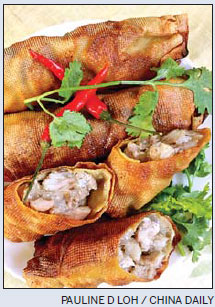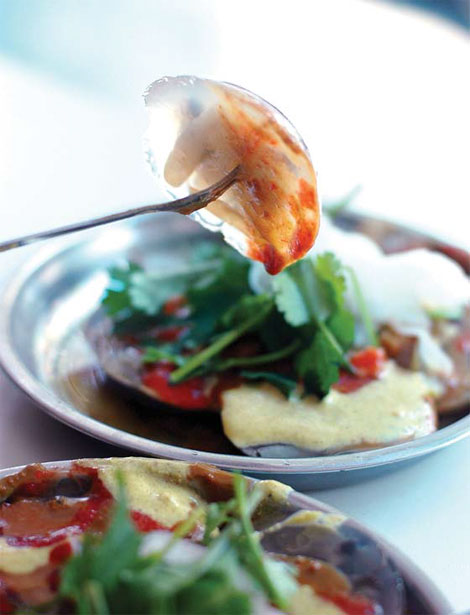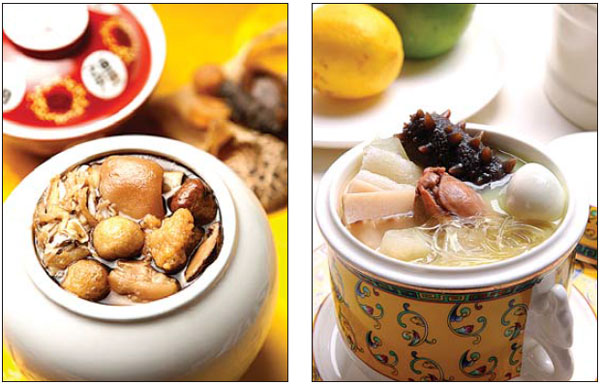Min cuisine: Pleasures from the land
Editor's note: To understand China, sit down to eat. Food is the indestructible bond that holds the whole social fabric together and it is also one of the last strong visages of community and culture.
Fujian is a province that enjoys ingredients harvested from its lofty hills and surrounding seas, with cooking styles and epicurean influences drawn from the neighboring Central Plains, Jiangsu province, Guangxi Zhuang autonomous region and Guangdong province, the culinary axis of southern China.
What makes this cuisine special is the natural practicality of its people, and the adventurous spirit that made them pioneers in emigration, mostly to Southeast Asia from as early as the 15th century.
|
Tusundong is a jellied snack made from a type of worm harvested from the beach. Mai Tian / For China Daily |
|
"Buddha jumps over the wall" is supposed to smell so good while it's cooking that even vegetarians would succumb. Photos Chai Shijue / For China Daily |
These early emigrants maintained close ties with home, and often returned after they had made their fortunes. They also brought dishes they had enjoyed abroad back to Fujian, adding exotic flavors seldom tasted elsewhere in China.
Here, you can eat shacharou, a beef or pork dish smothered in spicy peanut sauce that is strangely reminiscent of the satay skewers of Southeast Asia, but without the sticks.
There are many reasons why the native cuisine of Fujian is acknowledged as one of eight major styles of Chinese cooking. Known as Min cuisine after the ancient name of the region, it is appreciated for its clean, clear flavors, especially in its soups, the most famous of which must be "Buddha jumps over the wall".
This makes full use of local sanzhen haiwei - treasures from the mountain and sea - with a long list that includes the best local ham, long-legged free-range chicken, different types of mushrooms, and marine treasures such as sea cucumbers, mussels, fish maw, scallops and often a pigeon egg, all carefully sealed and double-boiled in a filtered top stock to create a crystal-clear consomme packed with flavor.
It is supposed to smell so good while it's cooking that even vegetarians would succumb - hence its rather whimsical name.
This opulent consomme originated from Fuzhou, the provincial capital and a city with its own distinctive gastronomic style, considered one of three chapters in the Fujian cookbook.
An outstanding feature of Min cuisine is the use of red yeast, fermentum rubrum, or hongqu, as seasoning. A second characteristic is the frequent use of good stock as the base of dishes and, finally, sweet and vinegary sauces are used to lift the palate in the full heat of year long warm weather.
In Fuzhou especially, red yeast is frequently used as a seasoning and appreciated for both its flavor and health benefits, and its use as a preservative. It is added to start the region's red rice wine as well.
Signature dishes tell interesting stories.
Besides its most famous soup, Fuzhou is known for its red yeast chicken, which is strangely similar to French coq au vin in both color and flavor. Red yeast is added to many stir-fries, especially for seafood such as sweet conch, clams and other shellfish.
A famous banquet staple is fish fillet first battered and deep-fried, then doused in a savory red gravy.
Because of its long coastline, Fujian cities such as Xiamen and Quanzhou boast many seafood specialties that appear in both banquet menus and street-side food stalls.
Restaurant specialties include seasonal seafood blanched in a high broth of chicken and pork bones, steamed or fried giant razor clams and minced prawns wrapped in bean curd skin before being deep-fried.
Street food offerings include the famous oyster omelets, a gelatinous tusundong made from a type of worm, and something known as fish balls.
First, the jellied worms are actually not of the common garden variety, but more a slender, anemone-like creature harvested from sandy coastlines during low tide. It is cleaned, then boiled and placed into ramekins. Once it is cooled, it becomes a firm jelly, which is doused in chili sauce, topped with coriander leaves and eaten as a snack.
Fish balls have nothing to do with reproductive organs, but are made entirely with fish meat. The flesh is carefully scraped off the fish bone and minced with just a little salt water. The resulting mixture is smacked repeatedly by hand in a mixing bowl until the fish meat acquires a bouncy texture. It is then shaped into balls and scalded in hot broth.
In areas of Fujian where the Hakka from the Central Plains settled, a salted fish and meat filling is added to the fish ball. They also like to stuff tofu and selected vegetables with this fish paste, giving rise to niang doufu, stuffed tofu.
There is another special product called rouyan or yanpi, which translates to "swallow meat" or "swallow skin".
This is made with pork, a full slab of which is hammered repeatedly until it is paper-thin and featherlight. It is then dried and used in soups or cut into wrappers for a savory filling of minced pork and fish.
Fujian is known for its tea plantations and orchards, so it's not surprising to know that another famous dish is lizhirou, or lychee meat.
It has nothing to do with the exotic fruit, but is considered so delicious and sweet that the locals think it resembles lychee. Made with minced water chestnuts and pork fillet cut in such a way that it curls tightly into a ball, the finished product has a nubby texture that reminds diners of the skin of the lychee fruit.
This dish is very representative of the sweet vinegary flavors of the region, and may well be a distant ancestor to the famous sweet and sour pork so beloved in overseas Chinese restaurants.
But it is Fujian street food that has gained prominence at home and abroad.
Wuxiang, or five-spice meat rolls, is popular not just in Fujian but in Thailand, the Philippines, Malaysia and Singapore - everywhere the early pioneers settled.
Similarly, baobing, vegetable-stuffed crepe rolls used as tummy fillers on the streets of Xiamen, have developed into more luxurious popiah in Malaysia and Singapore and lumpia in the Philippines.
All over China in major cities, franchises of Shaxian xiaochi offer good value for filling meals with noodles, rice and soups. In Beijing alone, our neighborhood has one on practically every block, even if no one realizes Shaxian is actually a county in Fujian.
Min cuisine keeps a relatively low profile compared with its more flamboyant cousins, but its presence certainly cannot be ignored.
paulined@chinadaily.com.cn
Classic homemade five-spice rolls
Ingredients:

300 g lean pork fillet, diced into 1 cm cubes
200 g belly pork, skinned and diced into 1 cm cubes
100 g pig liver, diced (optional)
1 red onion, finely diced
3 large sheets of dried bean curd skin, fupi
1 teaspoon Chinese five-spice powder
2 tablespoons tapioca or sweet potato starch
(substitute with corn starch)
1 teaspoon sugar
1 teaspoon salt
1 teaspoon black soy sauce
Method:
Marinate diced meats and onion with seasoning and starch. Mix well and stand for at least an hour, or overnight.
Wipe bean curd sheets with damp cloth and cut into 20 cm squares. Place five large spoons of marinated meats along one edge, roll up tightly. Repeat until filling is used up.
Place rolls on rack, steam over high heat for 10 to 15 minutes. Allow to cool. Rack prevents rolls from getting too soggy.
Just before serving, heat oil in a frying pan, deep-fry meat rolls over medium heat until golden-brown and crisp. Serve with sweet black soy sauce or chili dip.
(China Daily European Weekly 08/19/2016 page20)



 Print
Print Mail
Mail



